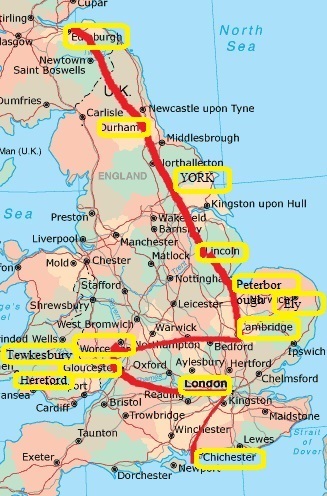U.K. 2013 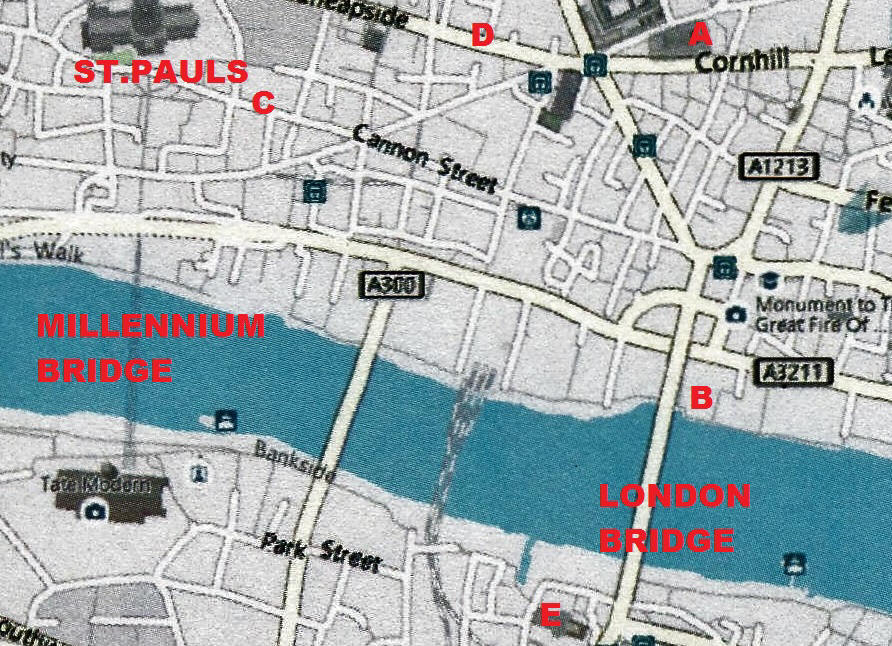
Day 18, Friday
September 20, 2013
London
Our plan for today was to meet my other papermodeler friend, Mike
Stamper and his wife, Val. Since the grocery store next door was being
remodeled, we had not found another one to buy breakfast supplies, so we
went to a Starbucks
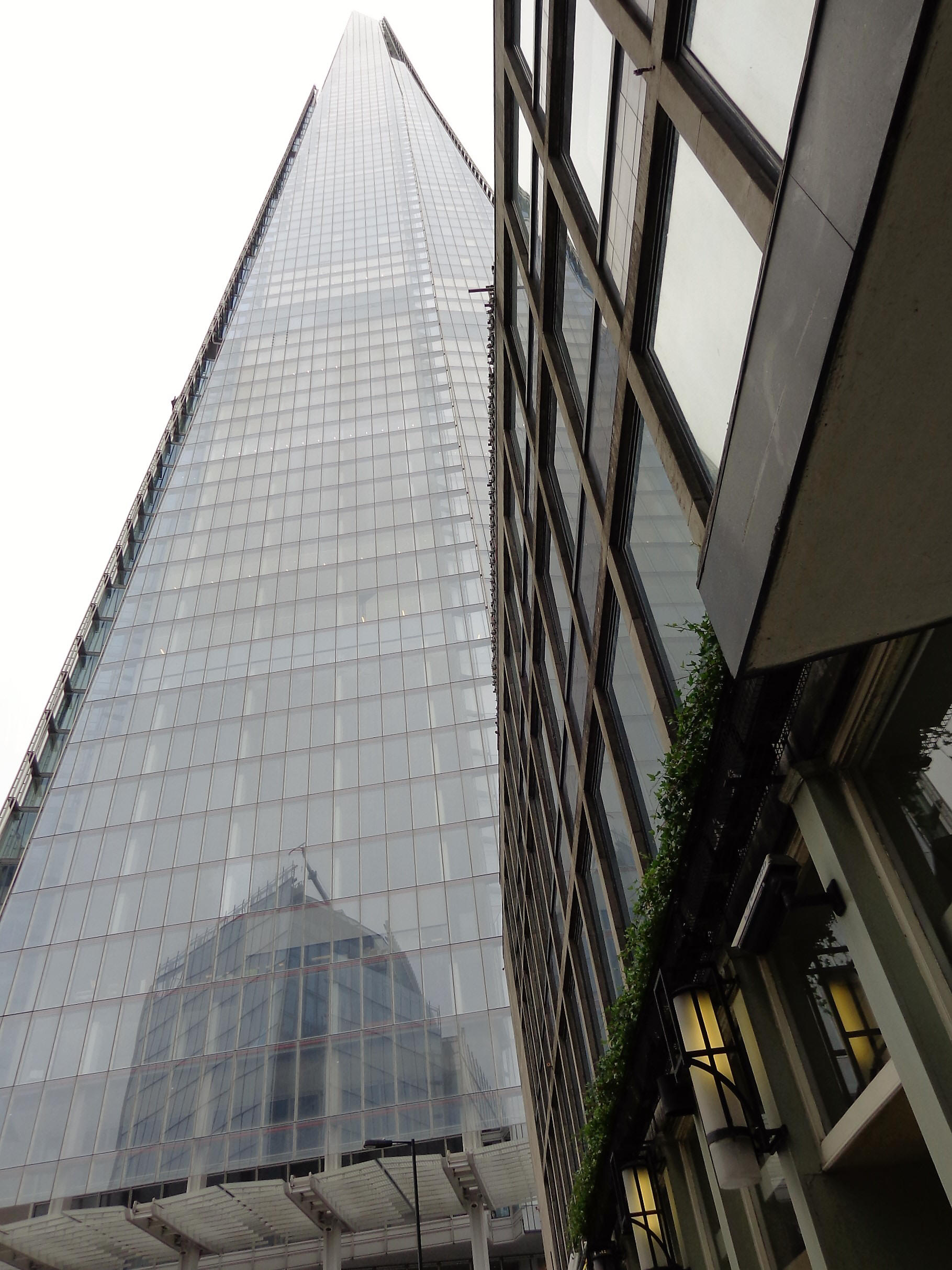 coffee and two sweets.
coffee and two sweets.
Then we walked up our street about a mile, passing the George Inn,
where we were last night and found the London Bridge station which is
located next to the Shard building, which is supposed to be the tallest
building in England and maybe Europe. Mike had sent us his photo plus
he said that he would be wearing red pants. We met exactly as planned.
They had ridden the train to London. The sky began turning blue and the
sun was shining. We were beginning to think that the sun never shined
in England. In fact, it was a beautiful day with a lot of sunshine.
It had to take off my hat and unzipped my jacket.
I first met Mike on line when he found my webpage. He is the one
who introduced me to www. papermodelers.com. He is an avid
papermodeler. We have been writing personal emails for over three
years. He and his wife were charming. He gave me a book on London’s
Cathedral and Churches plus a small book on the London Churches. (My
suit case is full of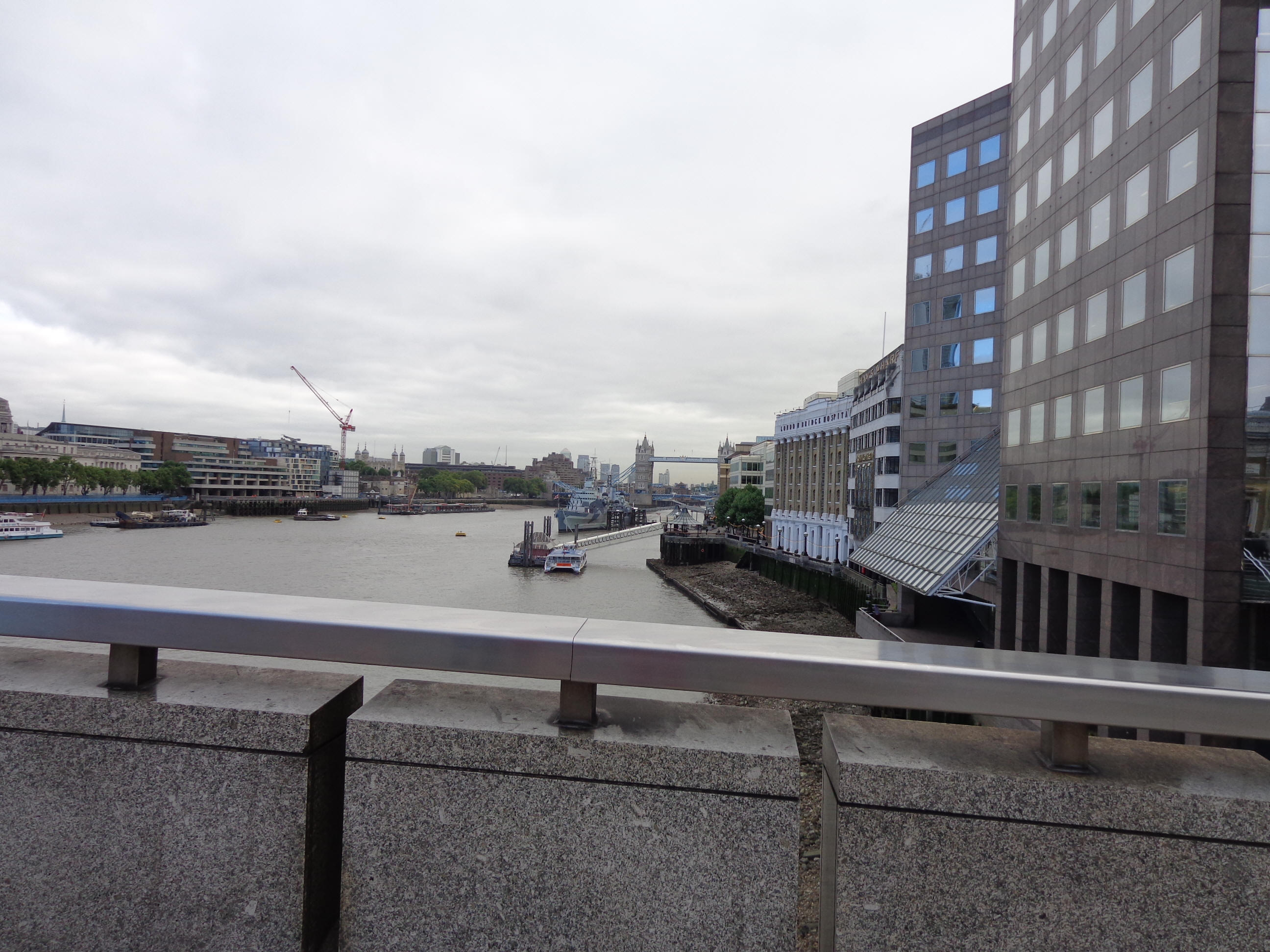 books as I have bought one at every church that we
have visited.)
books as I have bought one at every church that we
have visited.)
We started walking by crossing the London Bridge and winding around
the streets of The City, which is one square mile of finance, insurance,
and banking. London is quite a mixture of architecture with old
Victorian buildings next to modern all glass skyscrapers. They pointed
out all kinds of interesting places.
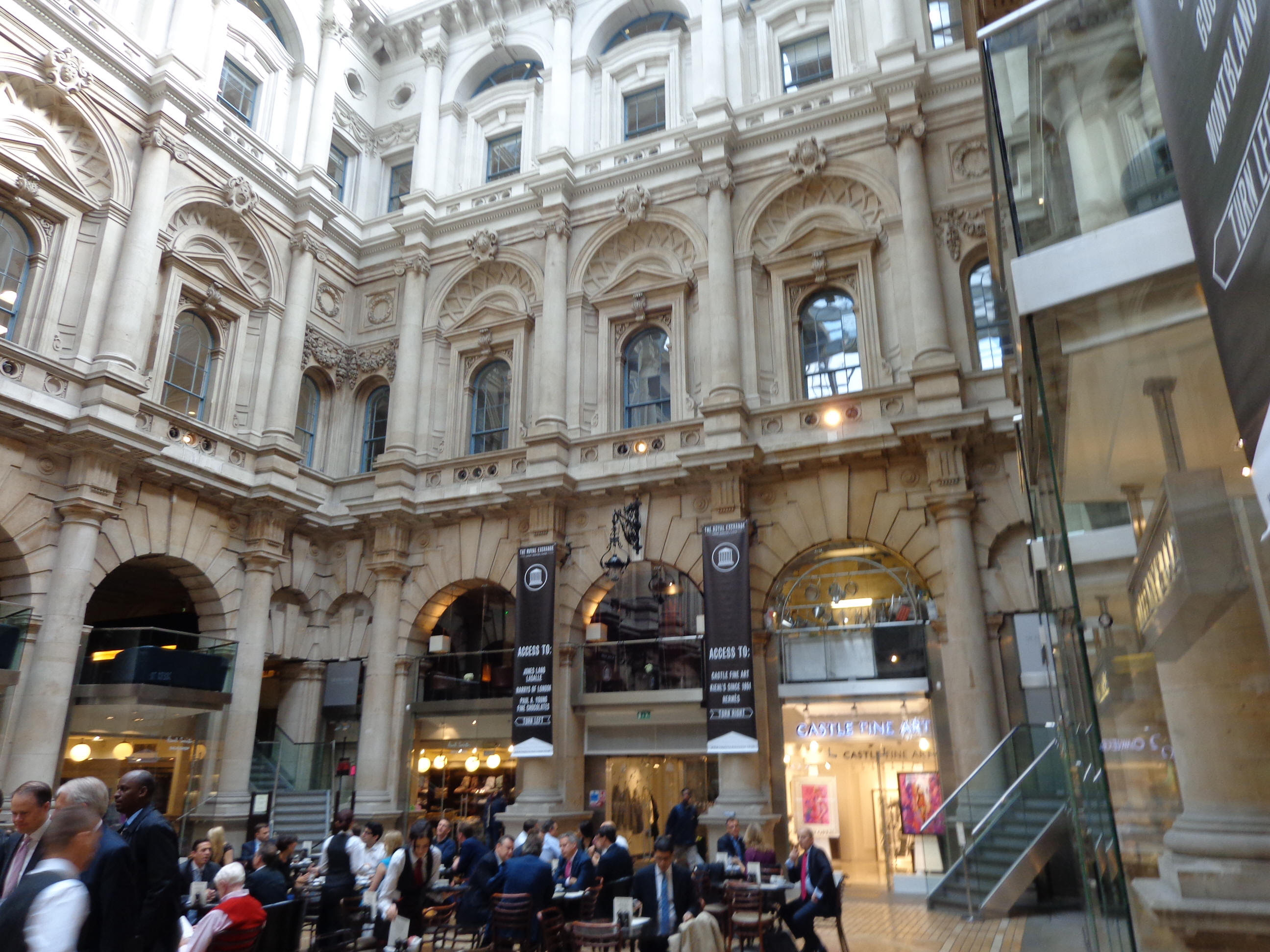
We went in the Royal Exchange Courtyard.
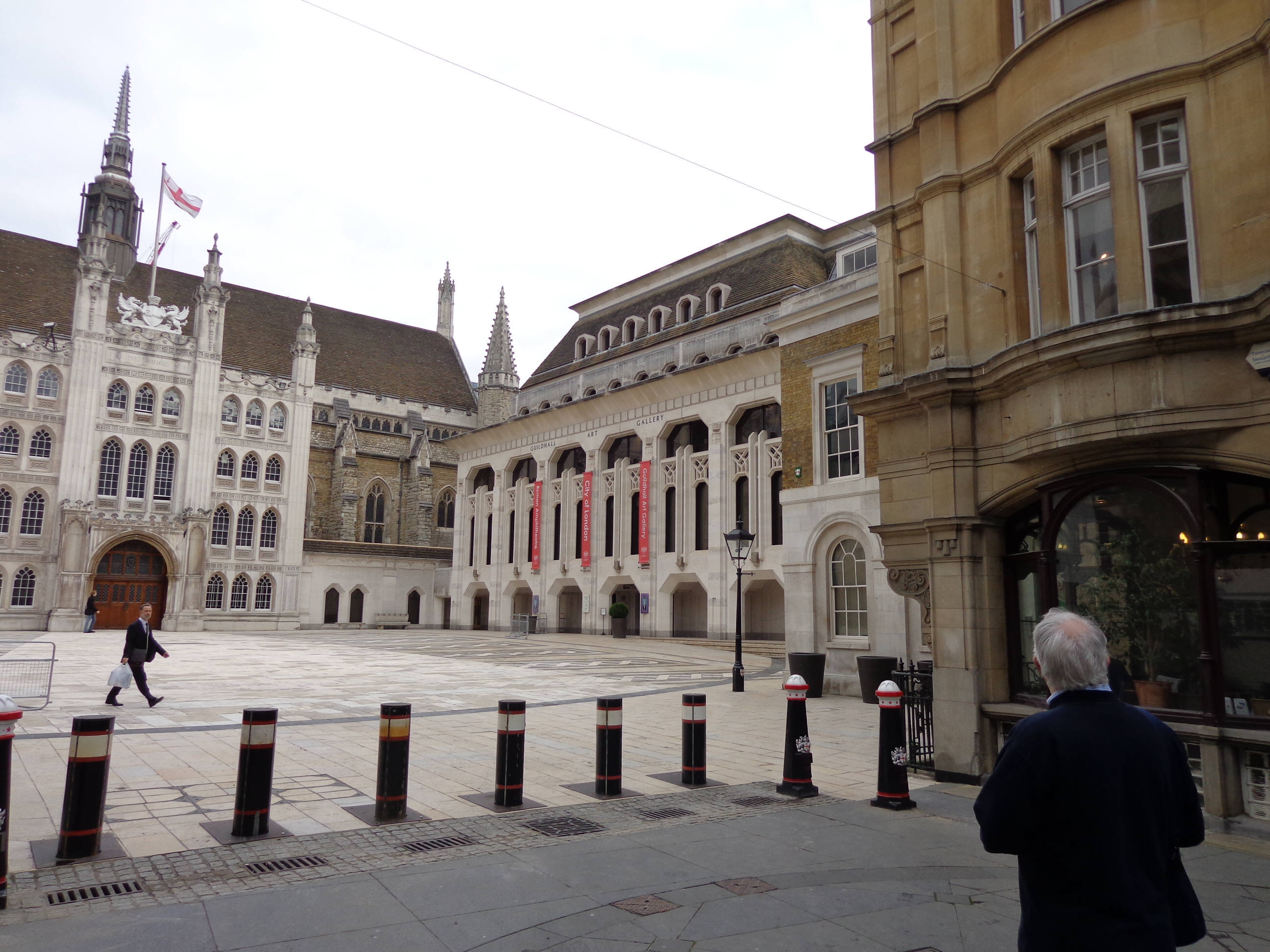
Next to the
Guildhall Art Galley where we visited the old Roman Amphitheatre ruins,
which were discovered under the building.
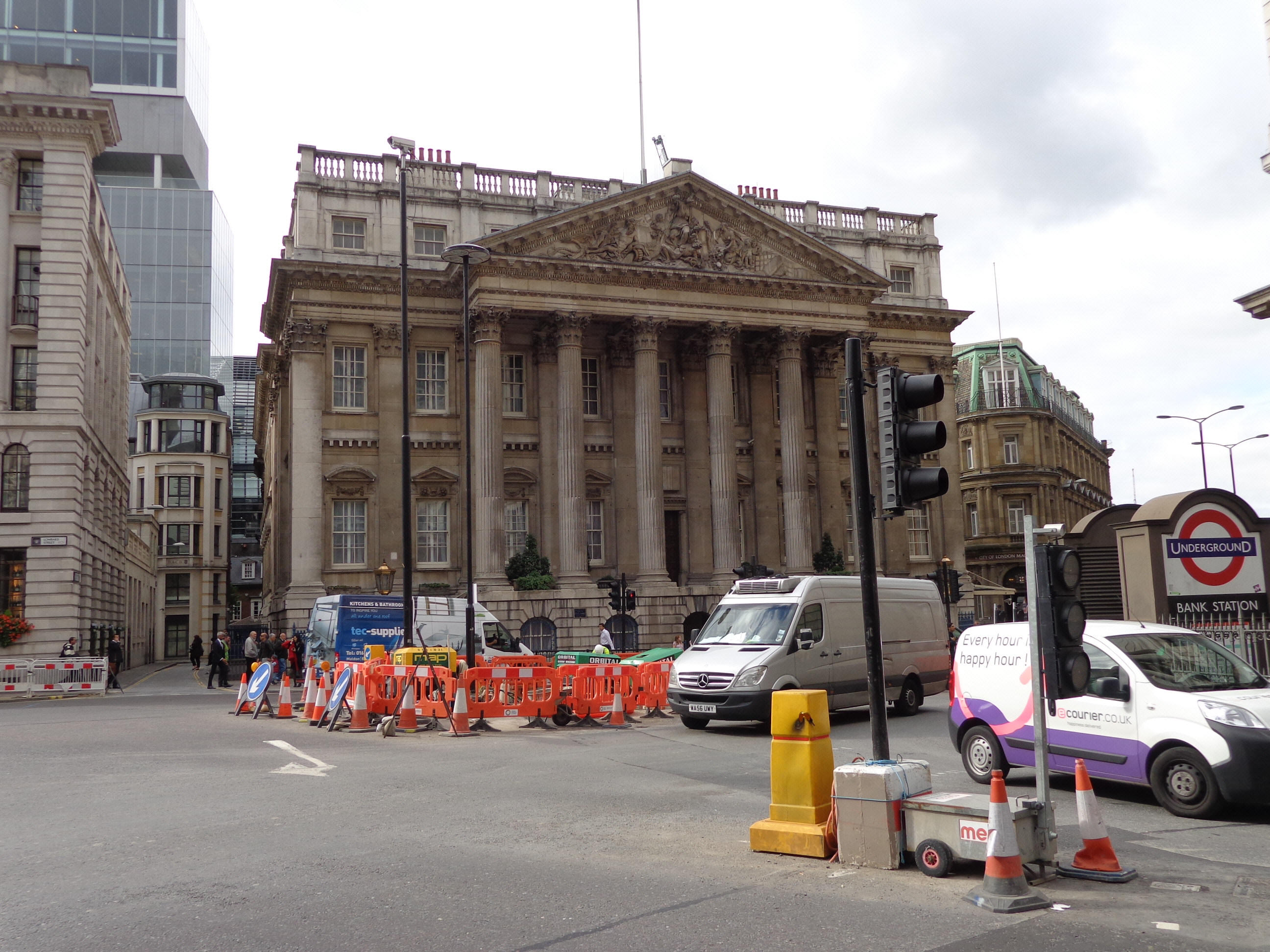
The Lord Mayor’s mansion is of
Greek style.
Mike and Val took us in four interesting old churches.
ST. MICHAEL, CORNHILL see ‘A’ on the map above
The Church lies over the remains of the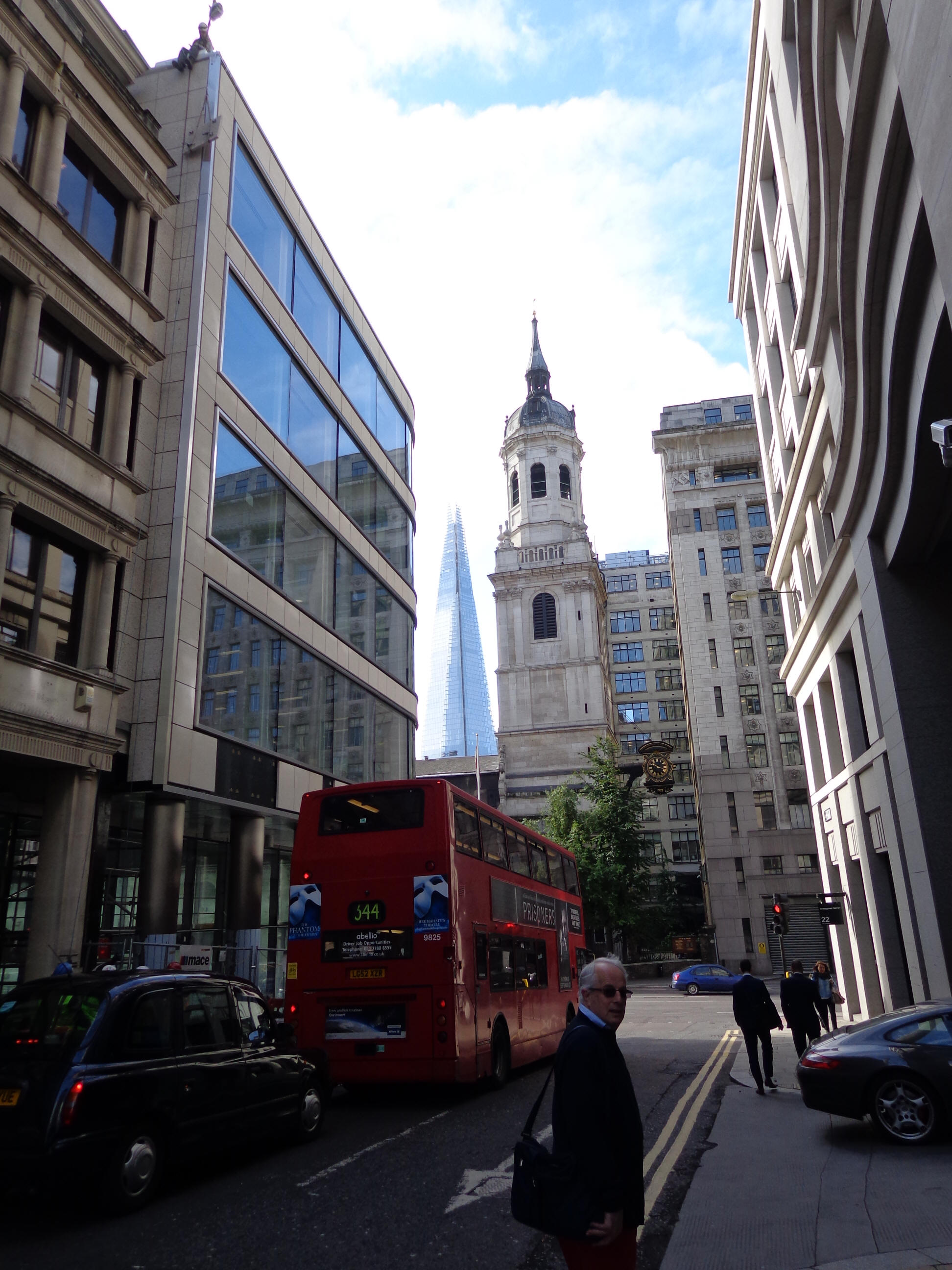 Basilica – the northern most
part of the great Roman Forum built in the first century AD. It stands
near to the site of a church founded by King Lucius in AD 179 - the
oldest site of Christian worship in London. The name ‘Cornhill’ is first
mentioned in the 12th century, the ‘hill’ indicating the rising ground
on which St. Michael’s stands, and ‘corn’ being derived from the
corn-market which was once held there.
Basilica – the northern most
part of the great Roman Forum built in the first century AD. It stands
near to the site of a church founded by King Lucius in AD 179 - the
oldest site of Christian worship in London. The name ‘Cornhill’ is first
mentioned in the 12th century, the ‘hill’ indicating the rising ground
on which St. Michael’s stands, and ‘corn’ being derived from the
corn-market which was once held there.
The Church of St. Michael’s is known to have been in existence
before the Norman Conquest.
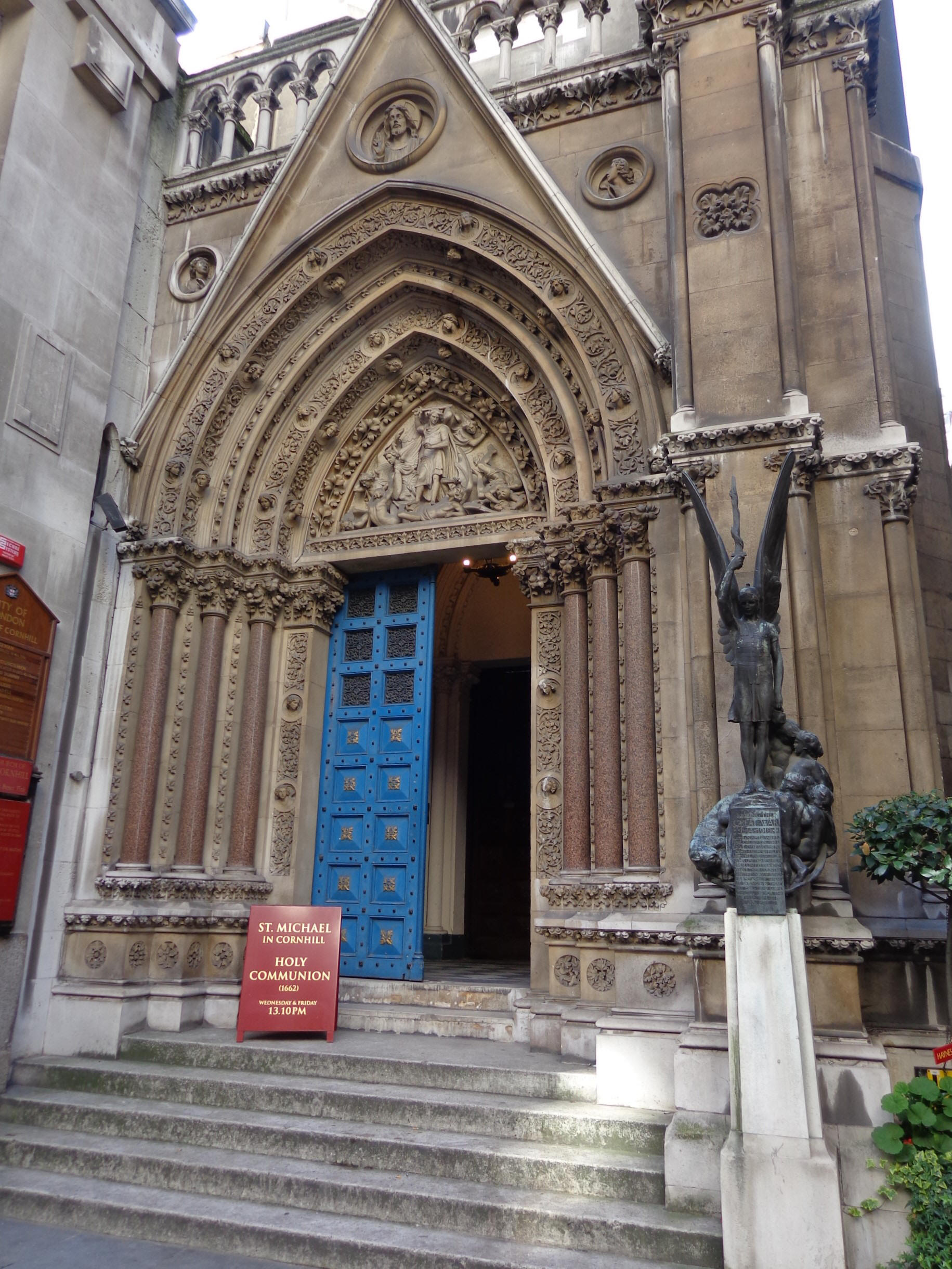 The Church, with the exception of the tower, was completely
destroyed in the Great Fire of 1666. The present Church was rebuilt by
Sir Christopher Wren between 1669 and 1672. The interior, with its
majestic Tuscan columns, was beautified and repaired in 1701 and again
in 1790. Pre-Victorian features that remain in the Church today include
17th paintings of Moses and Aaron incorporated into the reredos, as well
as a wooden sculpture of 'Pe
The Church, with the exception of the tower, was completely
destroyed in the Great Fire of 1666. The present Church was rebuilt by
Sir Christopher Wren between 1669 and 1672. The interior, with its
majestic Tuscan columns, was beautified and repaired in 1701 and again
in 1790. Pre-Victorian features that remain in the Church today include
17th paintings of Moses and Aaron incorporated into the reredos, as well
as a wooden sculpture of 'Pe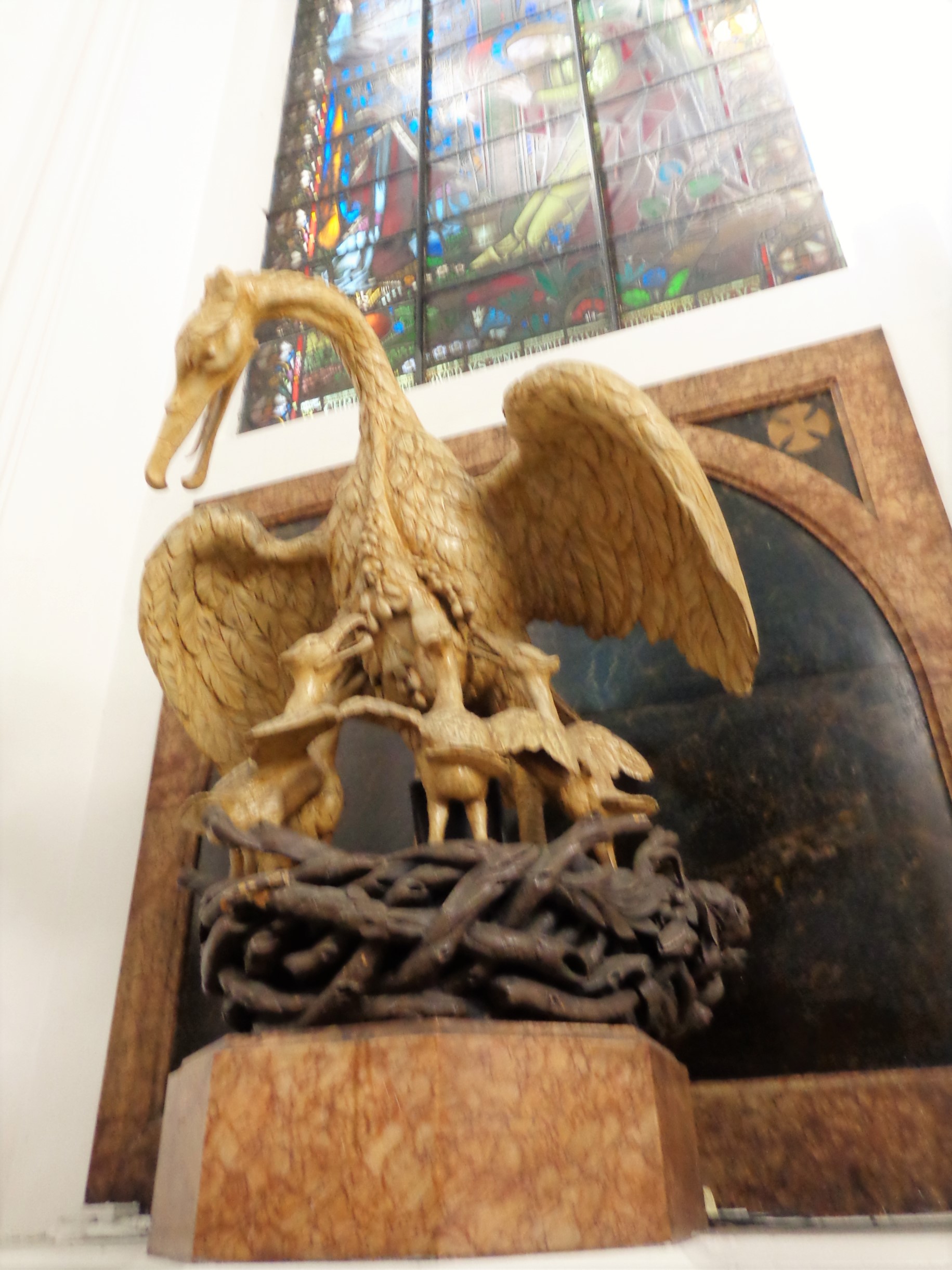 lican in her Piety' dating from 1775.
lican in her Piety' dating from 1775.
In 1716, the poet Thomas Gray, famous for his 'Elegy Written in a
Country Churchyard', was born in a milliner's shop adjacent to St.
Michael's and was baptized in the Church. The font in which this
occurred, dating from 1672, still remains. The tower was rebuilt in the
‘Gothick’ style between 1718 and 1722, the work being commenced by Wren
and completed by Nicholas Hawksmoor. It houses 12 bells, all of which
were originally cast by the Phelps Foundry of Whitechapel.
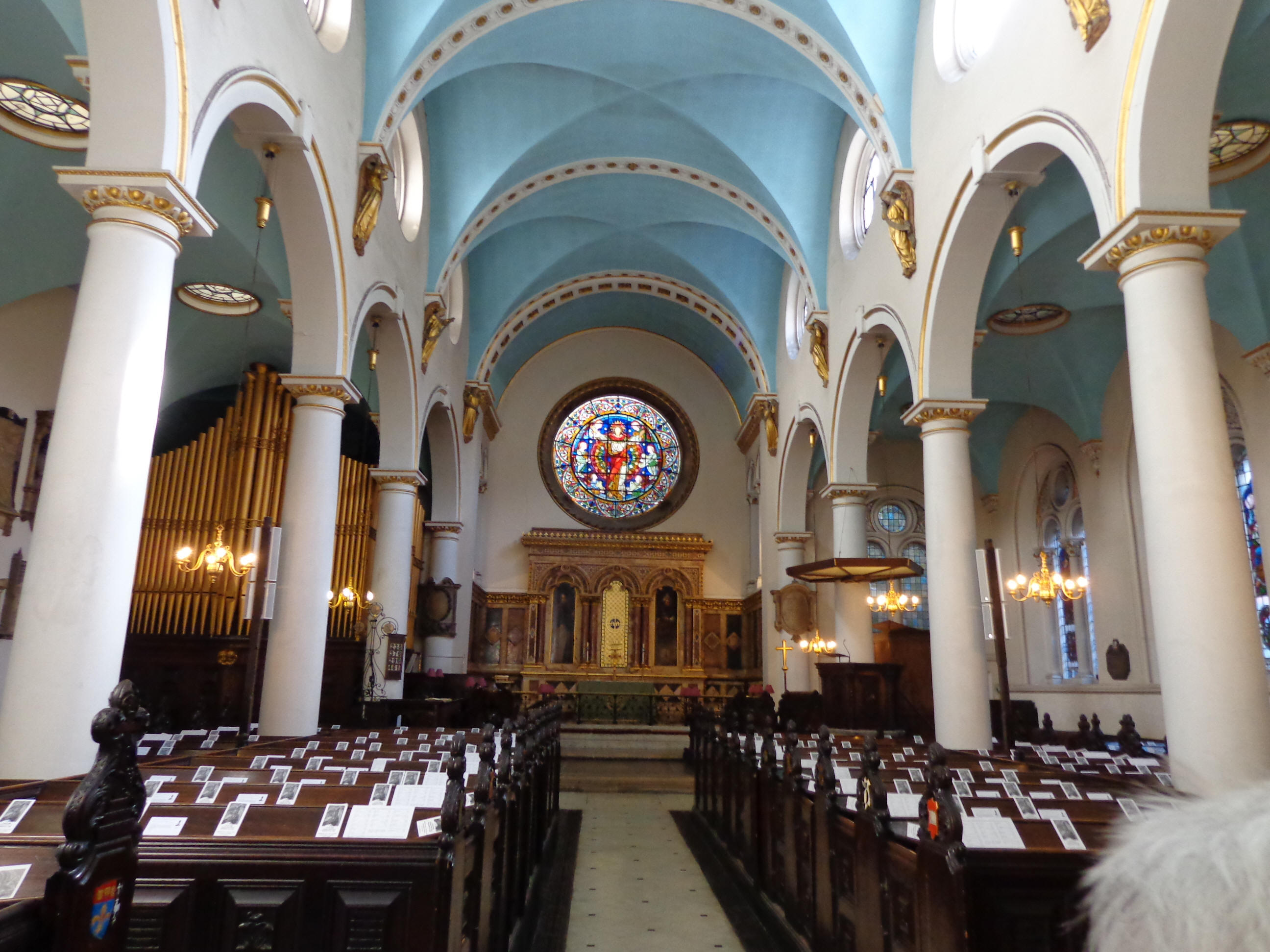 The interior was extensively remodelled in the High Victorian manner
by Sir George Gilbert Scott between 1857 and 1860. In addition, an
ensemble of stained glass was made by the firm Clayton & Bell and a new
porch, with a tympanum sculpture of St. Michael by John Birnie Philip,
was added.
The interior was extensively remodelled in the High Victorian manner
by Sir George Gilbert Scott between 1857 and 1860. In addition, an
ensemble of stained glass was made by the firm Clayton & Bell and a new
porch, with a tympanum sculpture of St. Michael by John Birnie Philip,
was added.
The Church was fortunate to escape serious damage in the Second
World War. The interior was restored in 1960, with the roofs and the
nave of the tower being renewed in 1975.
ST. MAGNUS THE MARTYR see “B” on map above
The church is dedicated to St Magnus the Martyr, earl of Orkney,
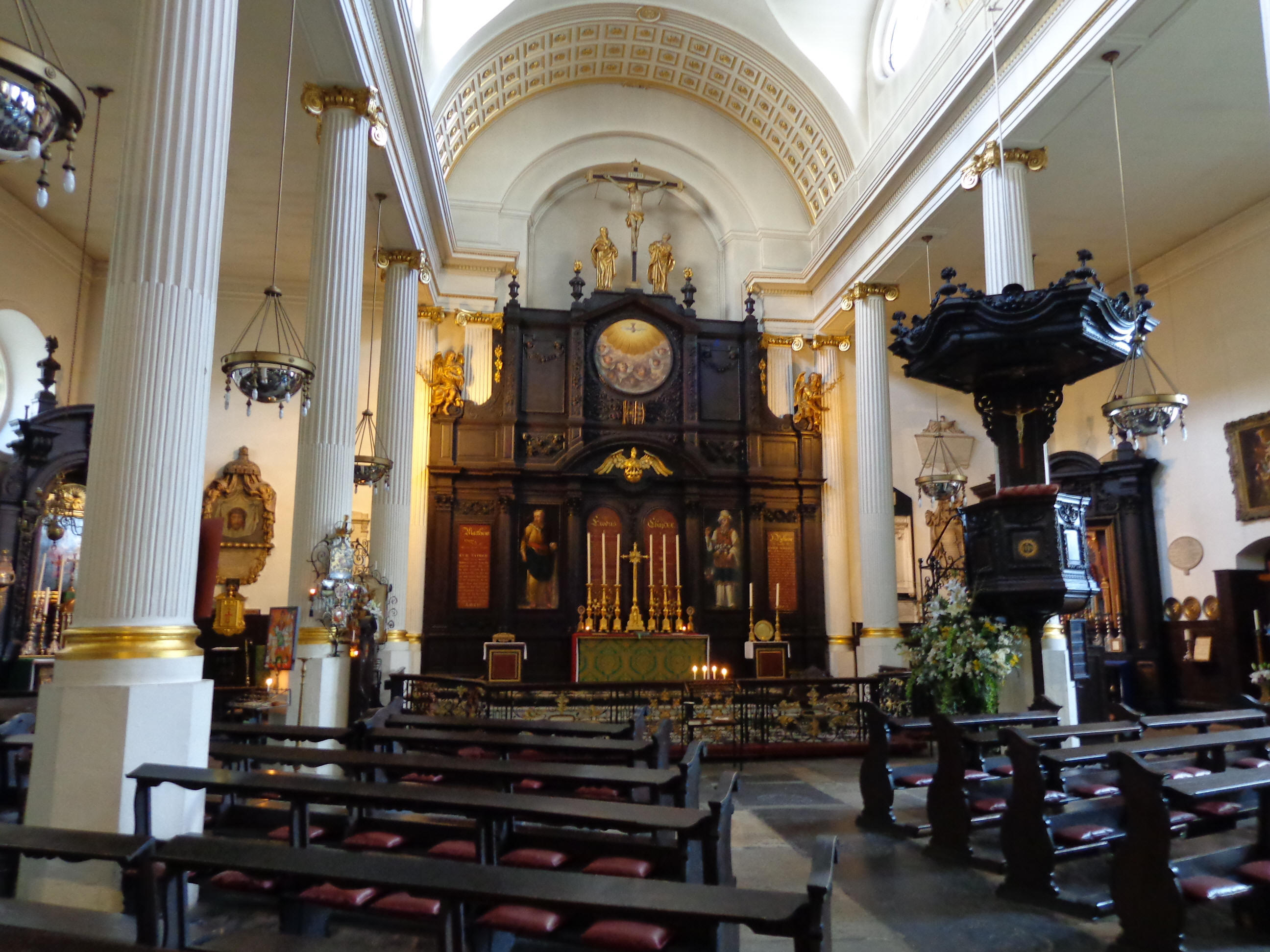 who
died on 16 April 1118. He was executed on the island of Egilsay having
been captured during a power struggle with his cousin, a political
rival. Magnus had a reputation for piety and gentleness and was
canonized in 1135.
who
died on 16 April 1118. He was executed on the island of Egilsay having
been captured during a power struggle with his cousin, a political
rival. Magnus had a reputation for piety and gentleness and was
canonized in 1135.
St. Magnus was situated at the north end of London Bridge,
until the bridge was moved in 1831. This church has a Christopher Wren
steeple and a very beautiful white and gold interior.
Sir Christopher Wren rebuild the body of the present church in 1671
after the great fire. The steeple is 185 feet tall and is based on that
of the church of St. Charles Borromee in Antwerp. A large 1700 clock
projected from the west side before 1831 but now is hidden away behind
the Adelaide house.
When we entered the church, we saw a tunnel vaulted ceiling with
tall Ionic columns with gilded capitals. These are the features that TS
Eliot famously mentioned in The Wasteland. The focus of the interior is
the magnificent reredos, which is double the normal size. The pulpit is
a fine example of a 17th century ornate design. Miles Coverdale, Bible
translator and a former rector, is buried here.
There is been a church on this site for over 900 years and its name
usually is taken to mean that it is the oldest of the city churches
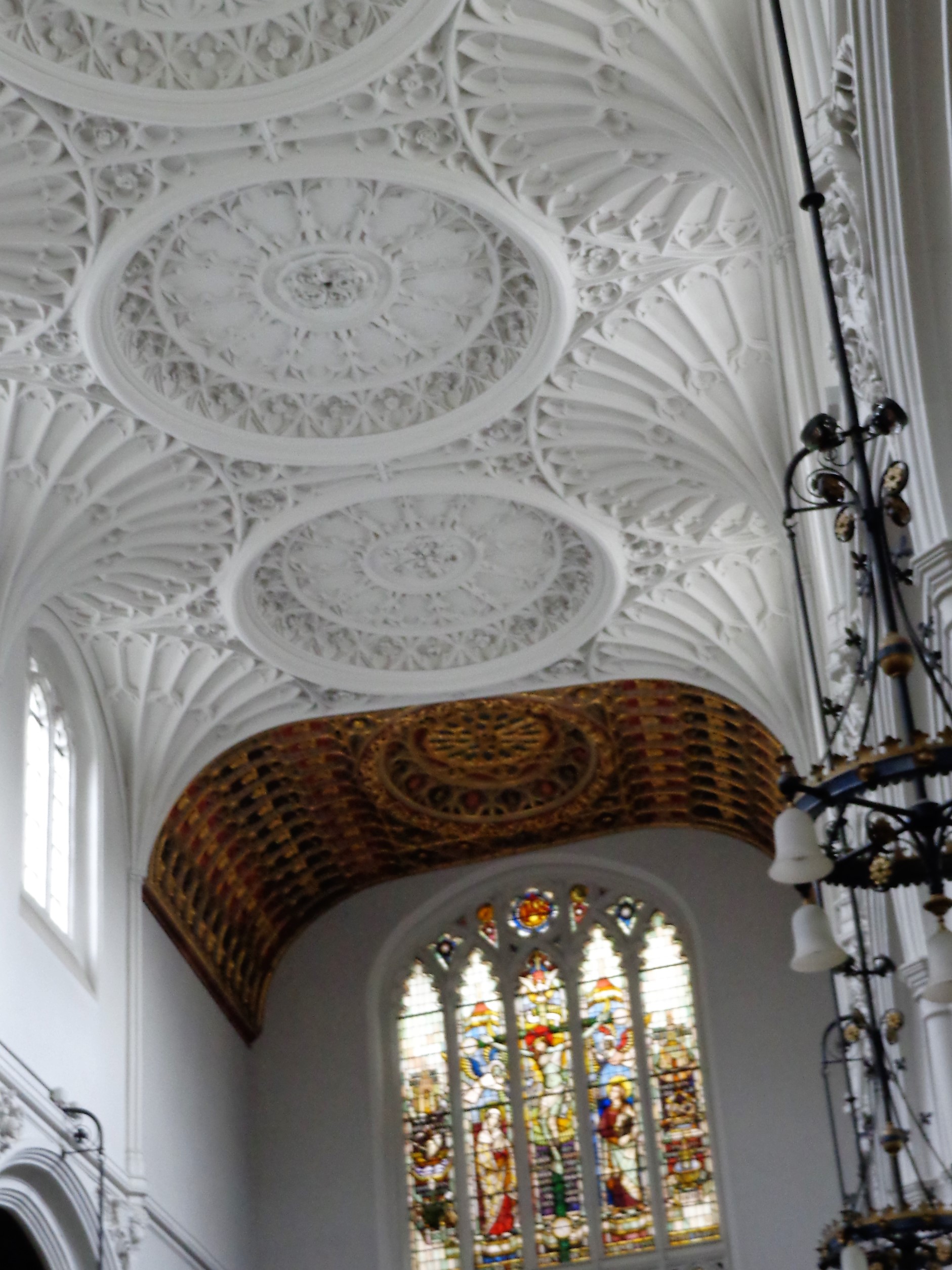 dedicated to the Virgin Mary. In 1510, Sir Henry Keeble, a grocer and
Lord Mayor, finance the building of a new church on the site. When he
died in 1518 tower was unfinished and was not completed until 1629. The
church was among the largest and finest of the city churches and a
number of notables were buried there.
dedicated to the Virgin Mary. In 1510, Sir Henry Keeble, a grocer and
Lord Mayor, finance the building of a new church on the site. When he
died in 1518 tower was unfinished and was not completed until 1629. The
church was among the largest and finest of the city churches and a
number of notables were buried there.
John Oliver, one of Christopher Wren’s deputies rebuilt the church
after the great fire, following the late perpendicular style of the Sir
Henry Keeble’s church. St. Mary Altermary is the only surviving Wren
church in the city of London built in the Gothic style. The Church
escaped relatively lightly in World War II. All the windows were
shattered and some plaster fell from the vaulting but the building
itself remained intact.
The tower is of perfect proportions. The interior is quite
magnificent with a beautiful fan vaulted ceiling.
St. Mary LeBeau was built by Christopher Wren in 1671 – 80.
I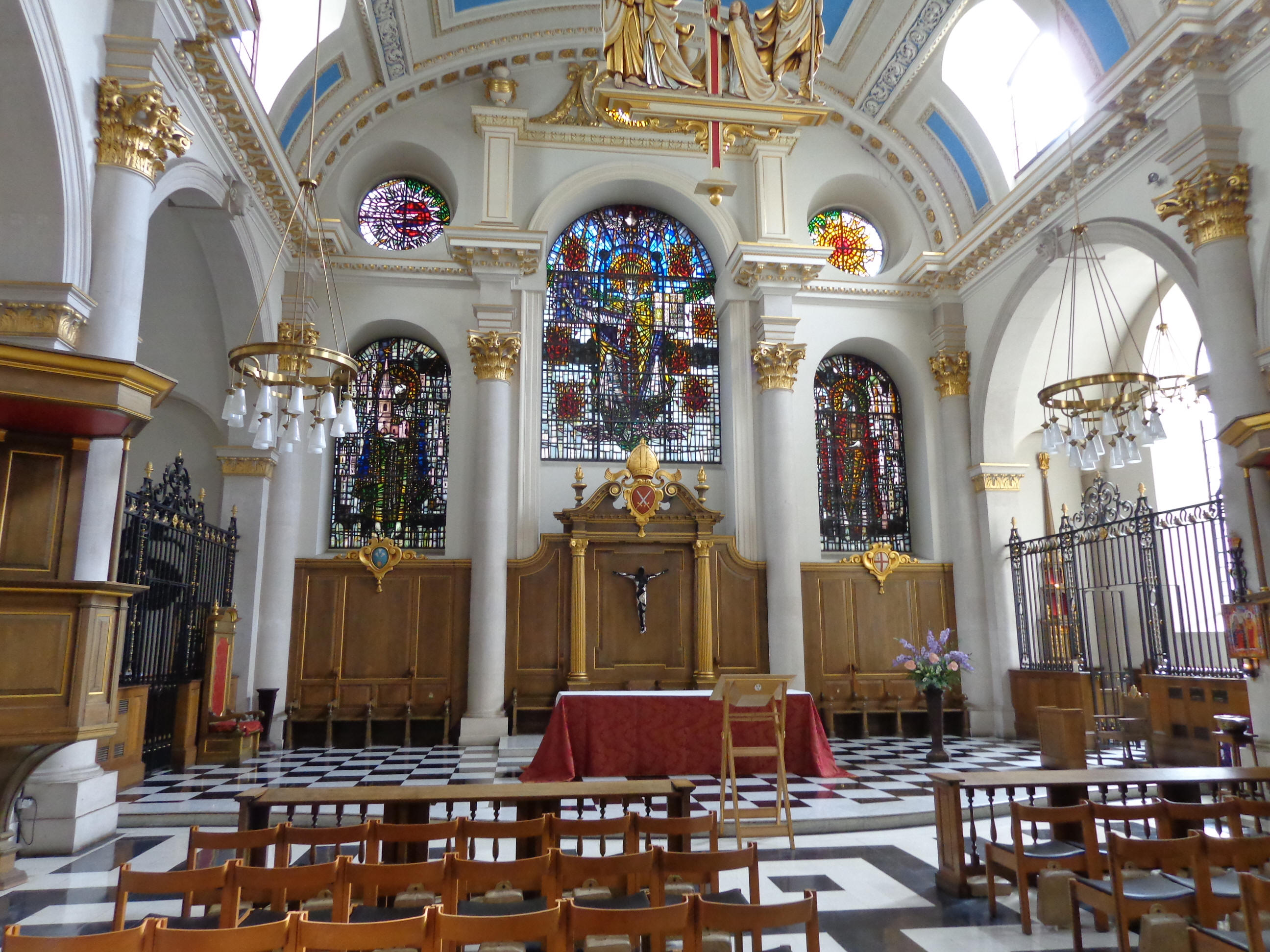 t cost more to build than any of the parish churches after the
great fire and almost half of the money was spent on the steeple, which
is 230 feet high and surmounted by a dragon vein 9 feet long.
t cost more to build than any of the parish churches after the
great fire and almost half of the money was spent on the steeple, which
is 230 feet high and surmounted by a dragon vein 9 feet long.
The present church is the work of Lawrence King in 1956 – 64,
reusing Wren’s walls and steeple. It was a restoration and classical
style which differs from Christopher Wren’s interior.
The body of the church is built in red brick with Portland stone
dressings. The barrel vaulted interior is only three bays long, but it
is wide, and because the aisles are so narrow it seems very spacious.
The bishop’s chair now stands north of the sanctuary, but it was
intended to stand against the east wall, as in ancient times. What
appears to be the reredos was meant to be the screen of honor for the
chair and not a normal altarpiece; the bishop’s miter in the arms of the
Bishop of London surmount it.
Opposite St. Paul’s Cathedral, which we visited
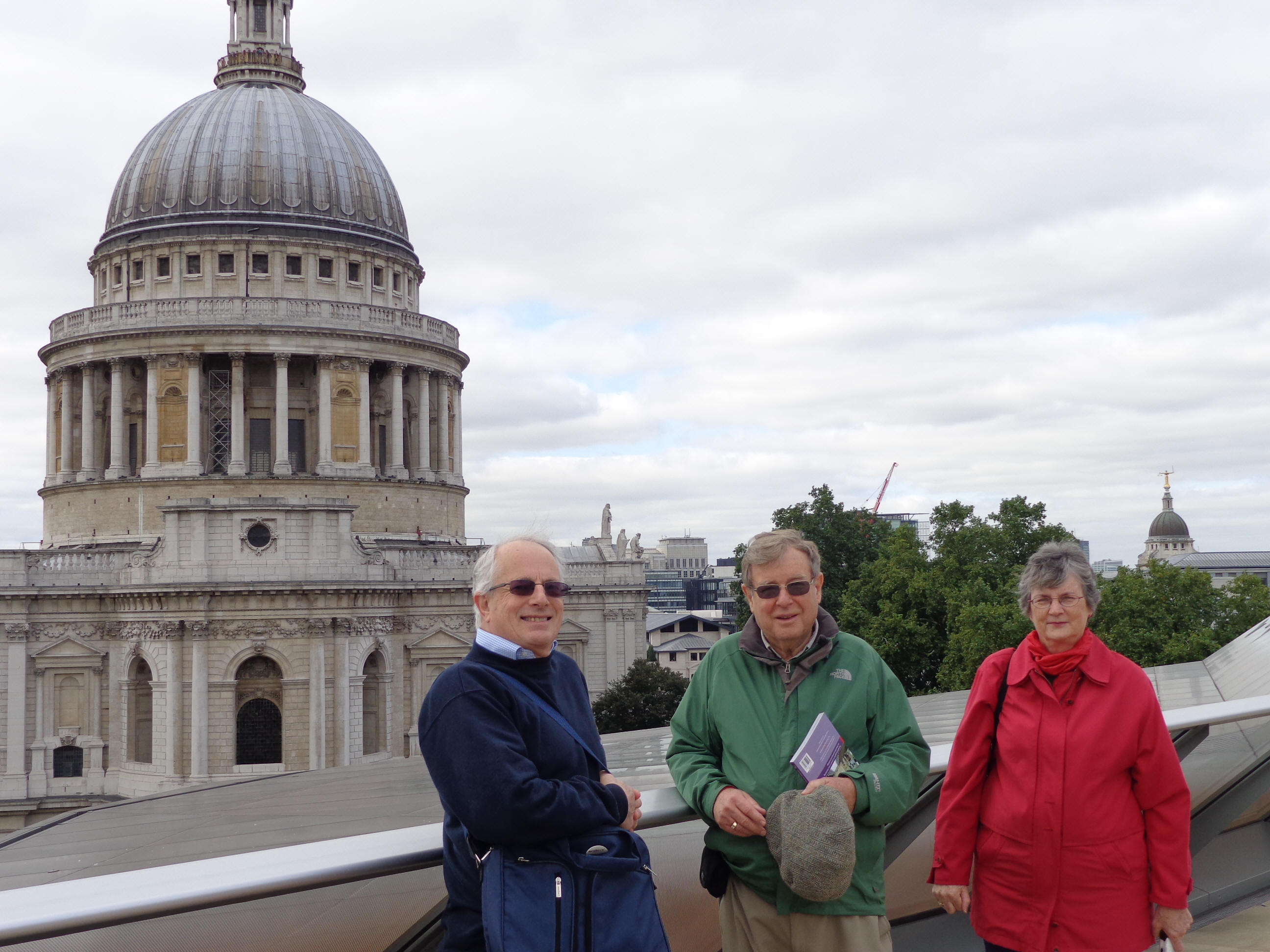 yesterday,
is a new eight story modern building called One New Chance, which was
completed in 2010. It is a shopping center with sixty shops and
restaurants. The roof top is accessible so we went on top which is
about level with St. Paul’s dome. The photo is of Mike, Me and Val.
There were wonderful views of London.
yesterday,
is a new eight story modern building called One New Chance, which was
completed in 2010. It is a shopping center with sixty shops and
restaurants. The roof top is accessible so we went on top which is
about level with St. Paul’s dome. The photo is of Mike, Me and Val.
There were wonderful views of London.
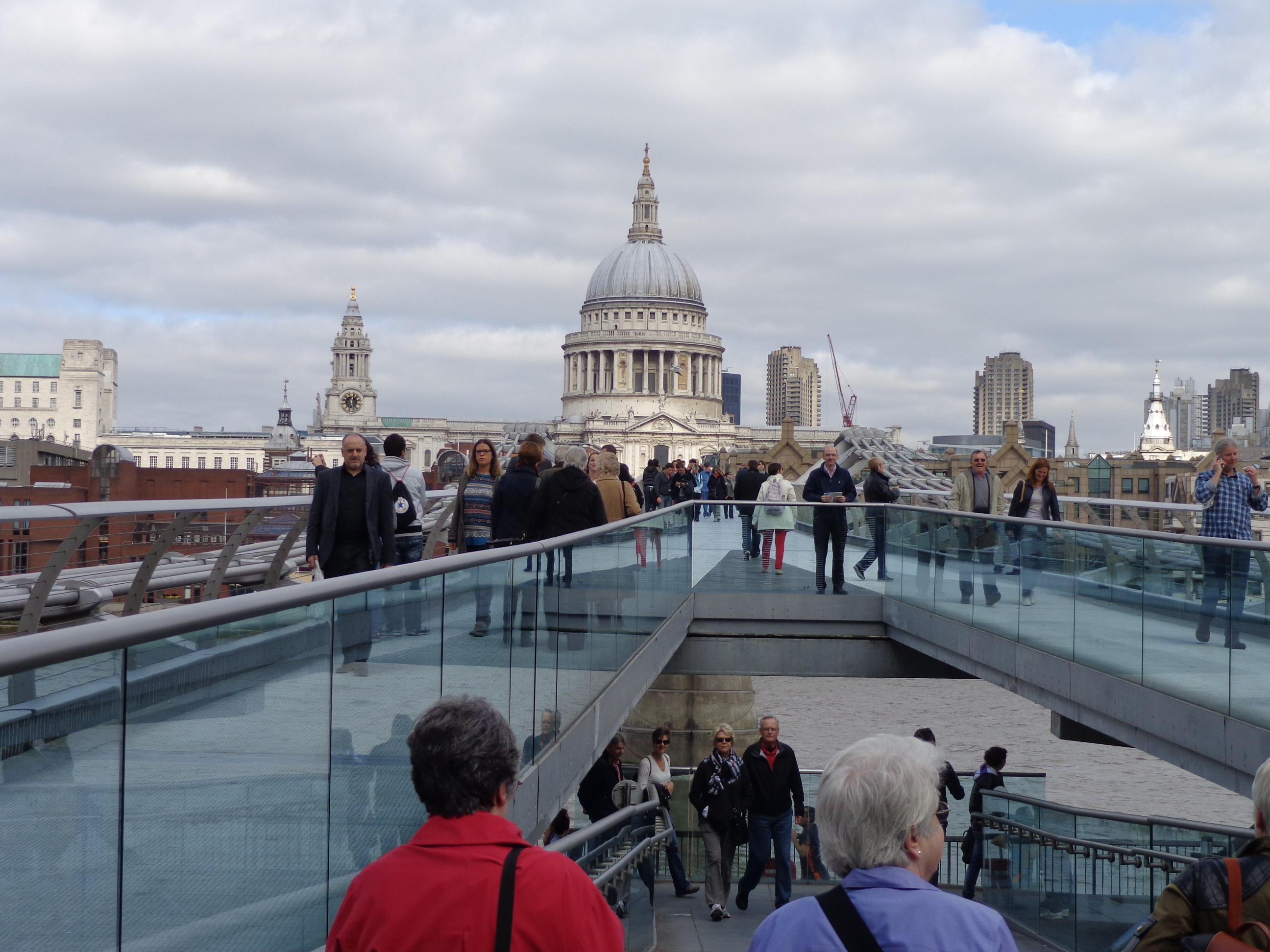 Then we walked across the Millennium Bridge which is a modern
foot bridge across the Thames. Looking back across the bridge, there is
a wonderful view of St. Paul’s Cathedral.
Then we walked across the Millennium Bridge which is a modern
foot bridge across the Thames. Looking back across the bridge, there is
a wonderful view of St. Paul’s Cathedral.
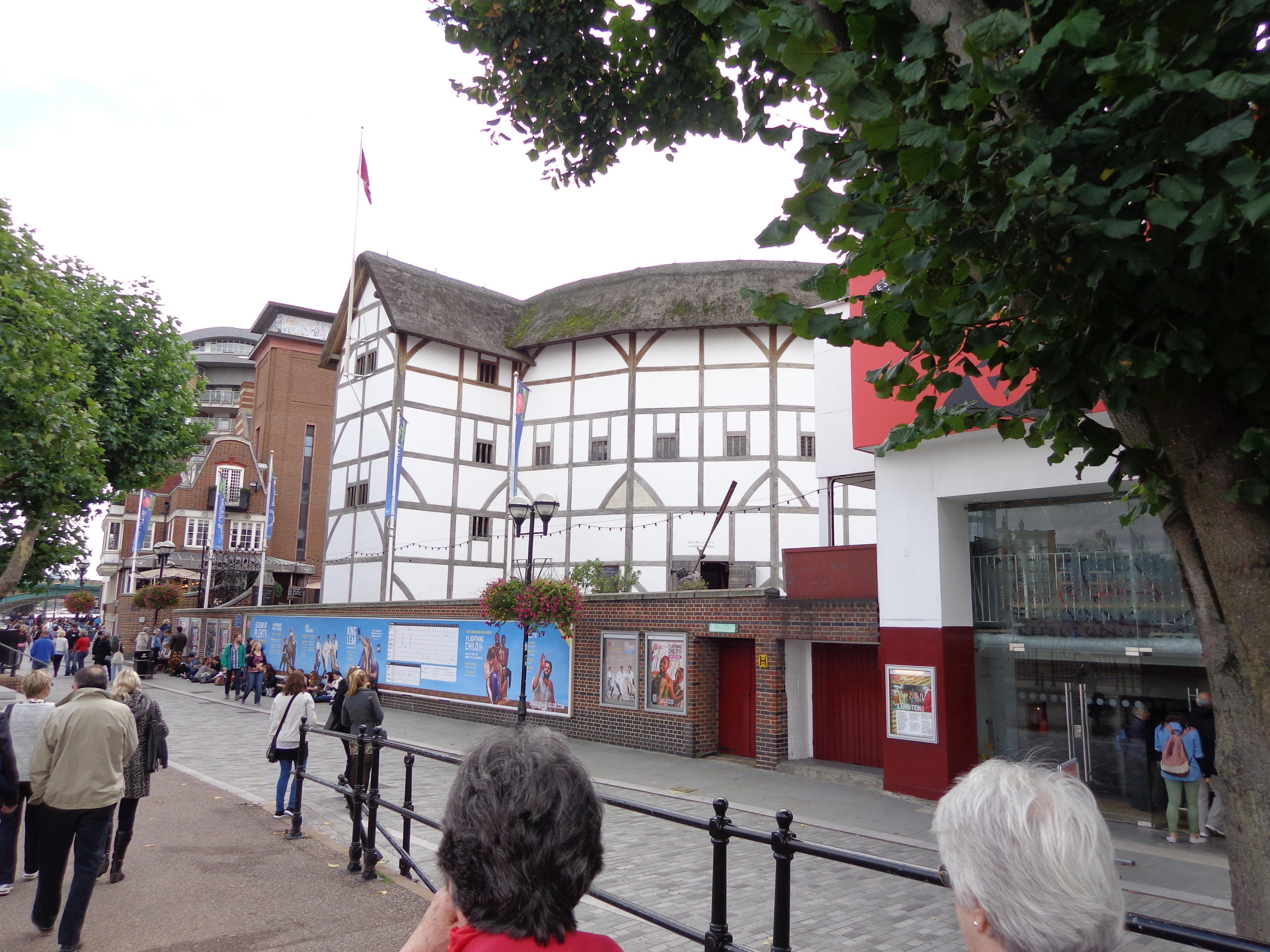
We walked past Shakespeare’s
Globe Theater, but did not go in. I have a model of it which I have not
yet made.
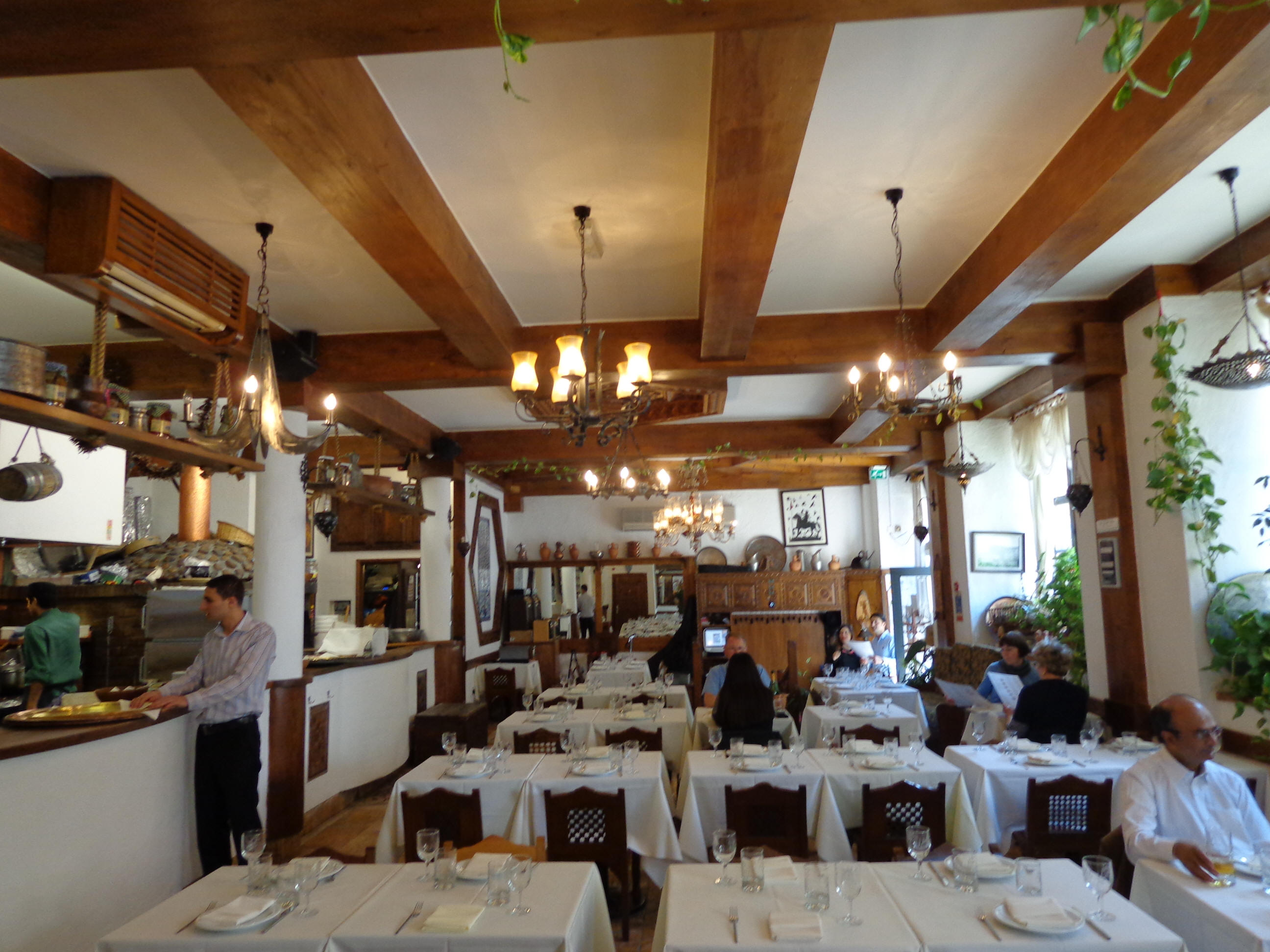
At 1:00 we stopped at the Tas Pide, a famous Turkish Restaurant.
Mike and Val evidently have eaten there often. We ordered a “Turkish
tapas” selection – about 8 bowls of different food. Each of us sampled
everything. It was very good, but I can’t tell you what it was.
After we ate, we walked a little and came to the Southwark Cathedral
which lies on the south bank of the river Thames close to the London
Bridge.
It is the mother church of the Anglican diocese of Southwark. It
has been a place of Christian worship for more than 1000 years. The
earliest reference to the site was in the Doomsday Book survey of 1086.
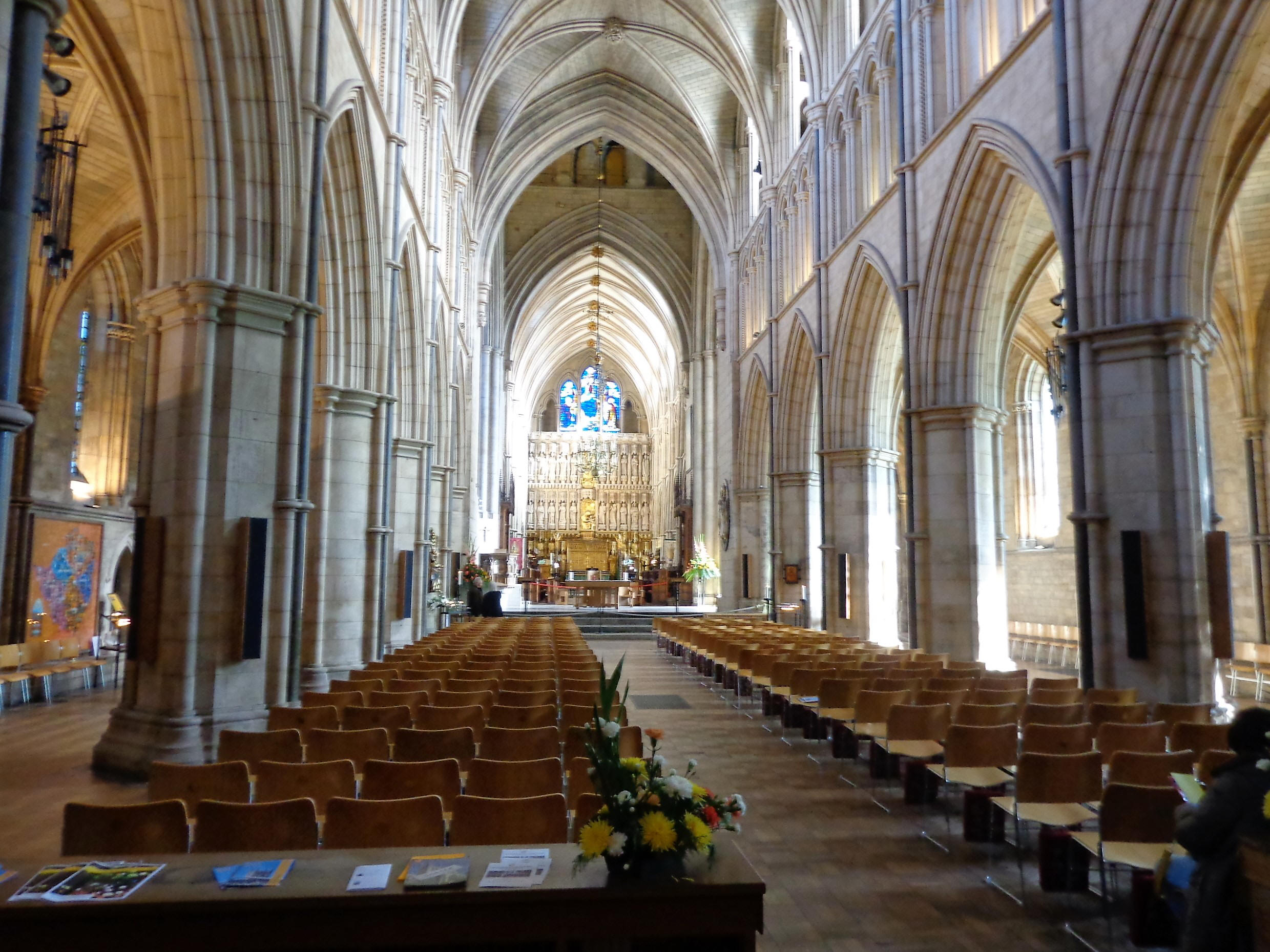 The church was severely damaged in the great fire of 1212.
Rebuilding took place during the 13th century. Followed by a another
fire in the 1390s. Following the dissolution of the monasteries under
Henry VIII, it became a parish church. The present building retains the
basic form from the Gothic structure built between 1220 and 1420.
The church was severely damaged in the great fire of 1212.
Rebuilding took place during the 13th century. Followed by a another
fire in the 1390s. Following the dissolution of the monasteries under
Henry VIII, it became a parish church. The present building retains the
basic form from the Gothic structure built between 1220 and 1420.
By the early 19th century the fabric of the church had fallen into
disrepair. All of the medieval furnishings were gone and the interior
was in terrible condition. Between 1818 and 1830 the tower and the choir
were restored in effort to return to church to his 13 century
appearance.
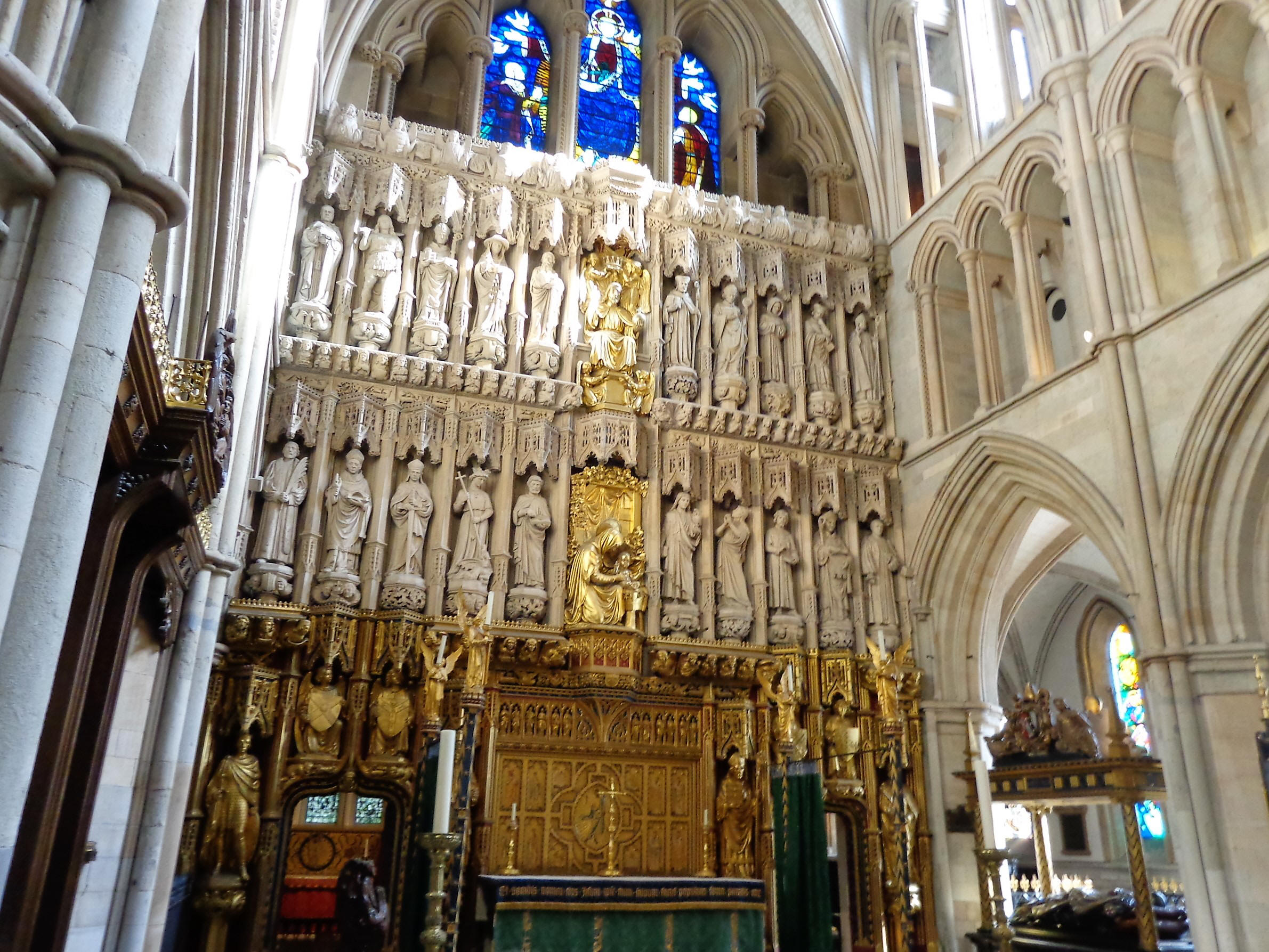
In 1831 the nave roof which had become unsafe was removed, leaving
the interior open to the weather. In 1839 nave was demolished and
rebuilt.
The parish church was designated as a Cathedral in 1905 when the
church of England diocese of South work was created. The cathedral
stands in a heavily damaged area by German bombings during the Second
World War. Of the 1600+ bombs they were dropped in the area only one
damaged the cathedral.
The interior was very beautiful with a long nave leading to a choir
and a magnificently carved reredos behind the altar. This church has
been associated with many famous people.
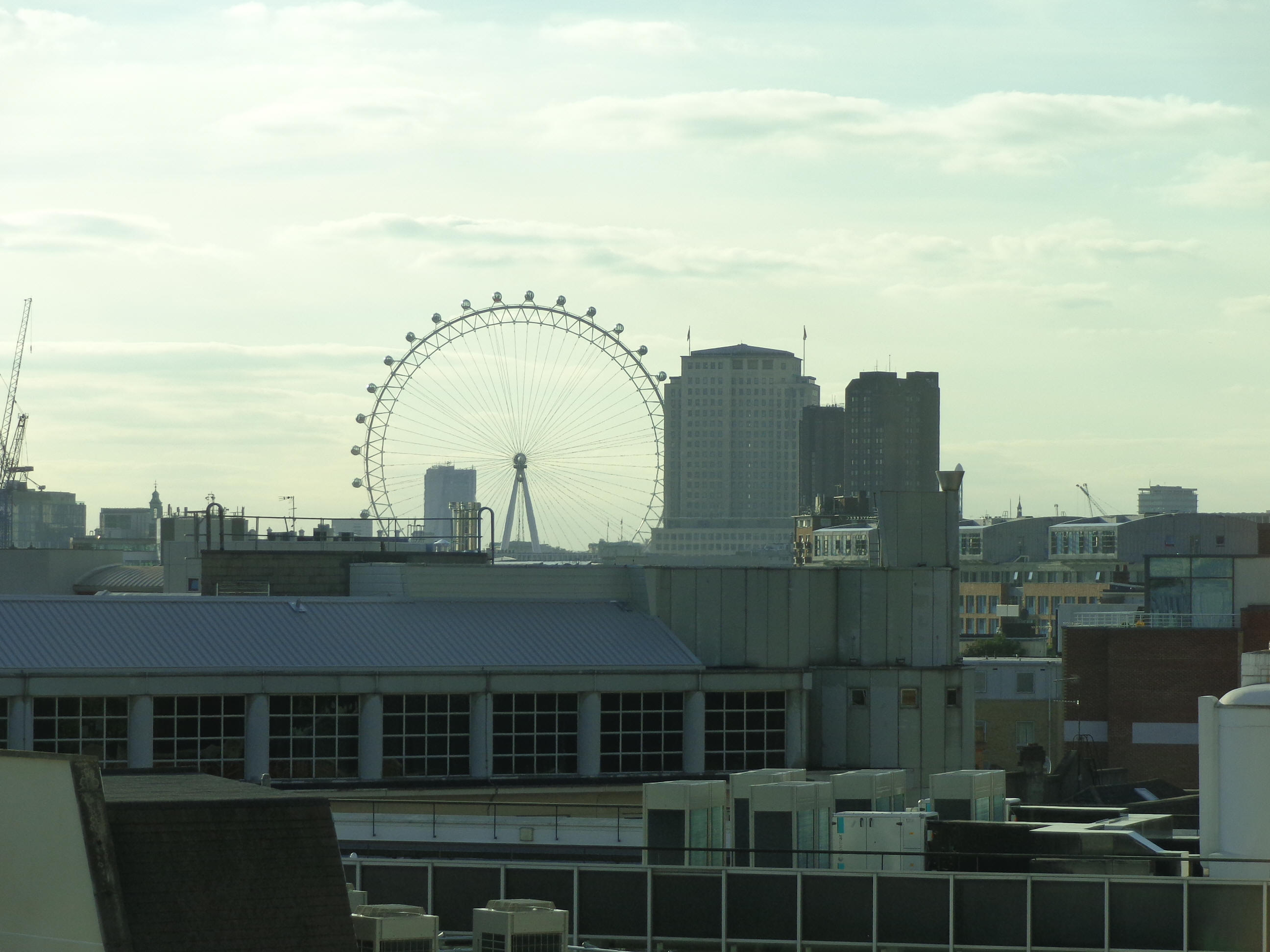 In a few blocks we were back to London Bridge station where we
started.. making a big loop. Mike and Val headed for the train, and we
walked back to our apartment. We found a grocery and bought some
breakfast food. We got home about 3:00. We have a washer dryer in
the apartment so we did a washing.
In a few blocks we were back to London Bridge station where we
started.. making a big loop. Mike and Val headed for the train, and we
walked back to our apartment. We found a grocery and bought some
breakfast food. We got home about 3:00. We have a washer dryer in
the apartment so we did a washing.
At 7:00 boarded the tube for the Tower of London. We have dinner
reservations in a fine restaurant under the Tower Bridge. Afterward we
had tickets to the Ceremony of the Keys at the Tower of London.
We took the tube from around the corner then chan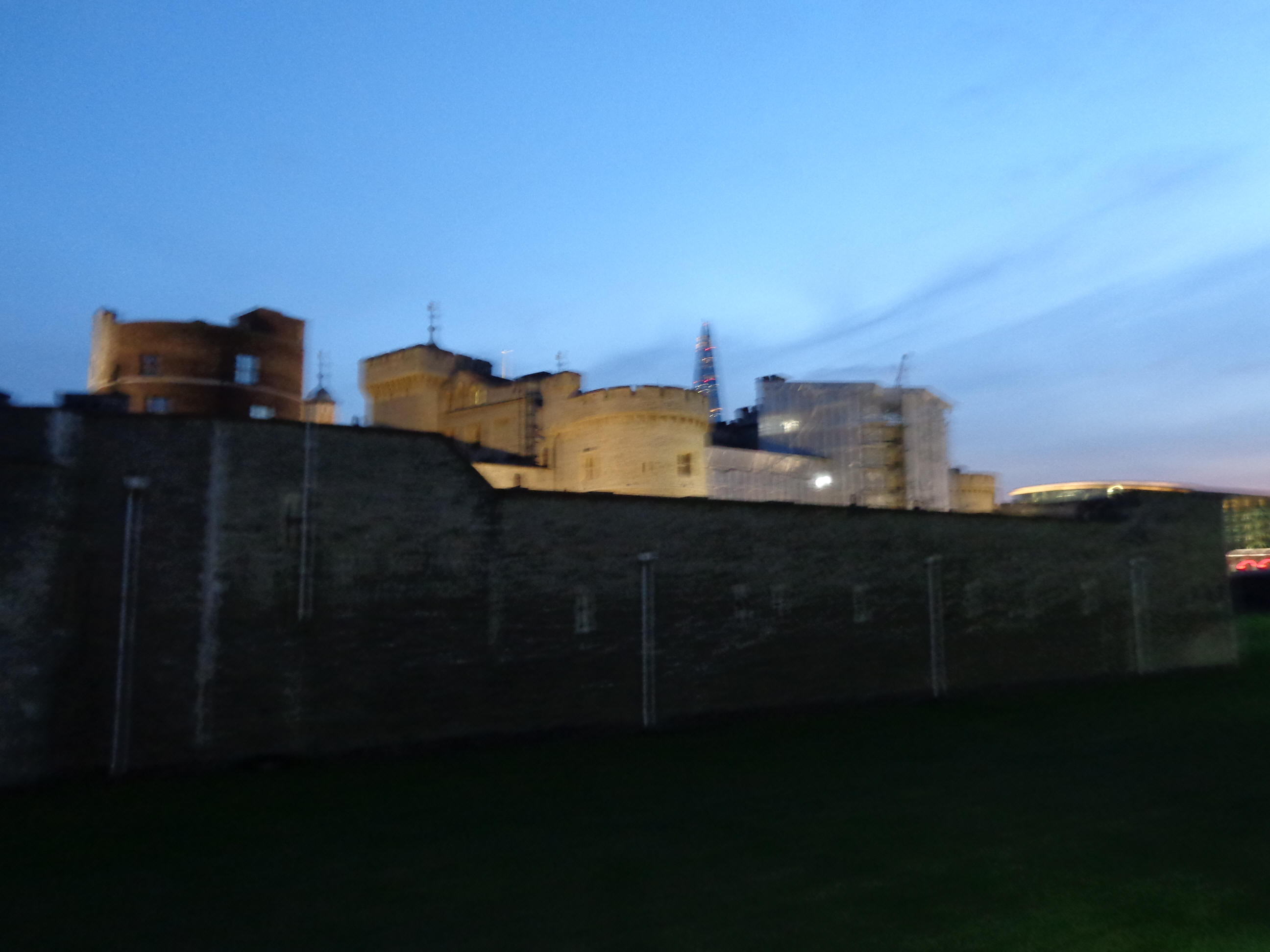 ged metros
and got off a Tower Bridge. We wandered around a little until we found
our restaurant, Perkins Reveler, which is located under the bridge. We
had a very good dinner. I had salmon and Kathleen had sea bream and a
pear tart for dessert. Kathleen had a glass of English sparkling wine.
It was good. For security, the lower gate to the Tower of London is
closed at 9 pm. It’s the gate we needed, so we had to walk all the way
around again.
ged metros
and got off a Tower Bridge. We wandered around a little until we found
our restaurant, Perkins Reveler, which is located under the bridge. We
had a very good dinner. I had salmon and Kathleen had sea bream and a
pear tart for dessert. Kathleen had a glass of English sparkling wine.
It was good. For security, the lower gate to the Tower of London is
closed at 9 pm. It’s the gate we needed, so we had to walk all the way
around again.
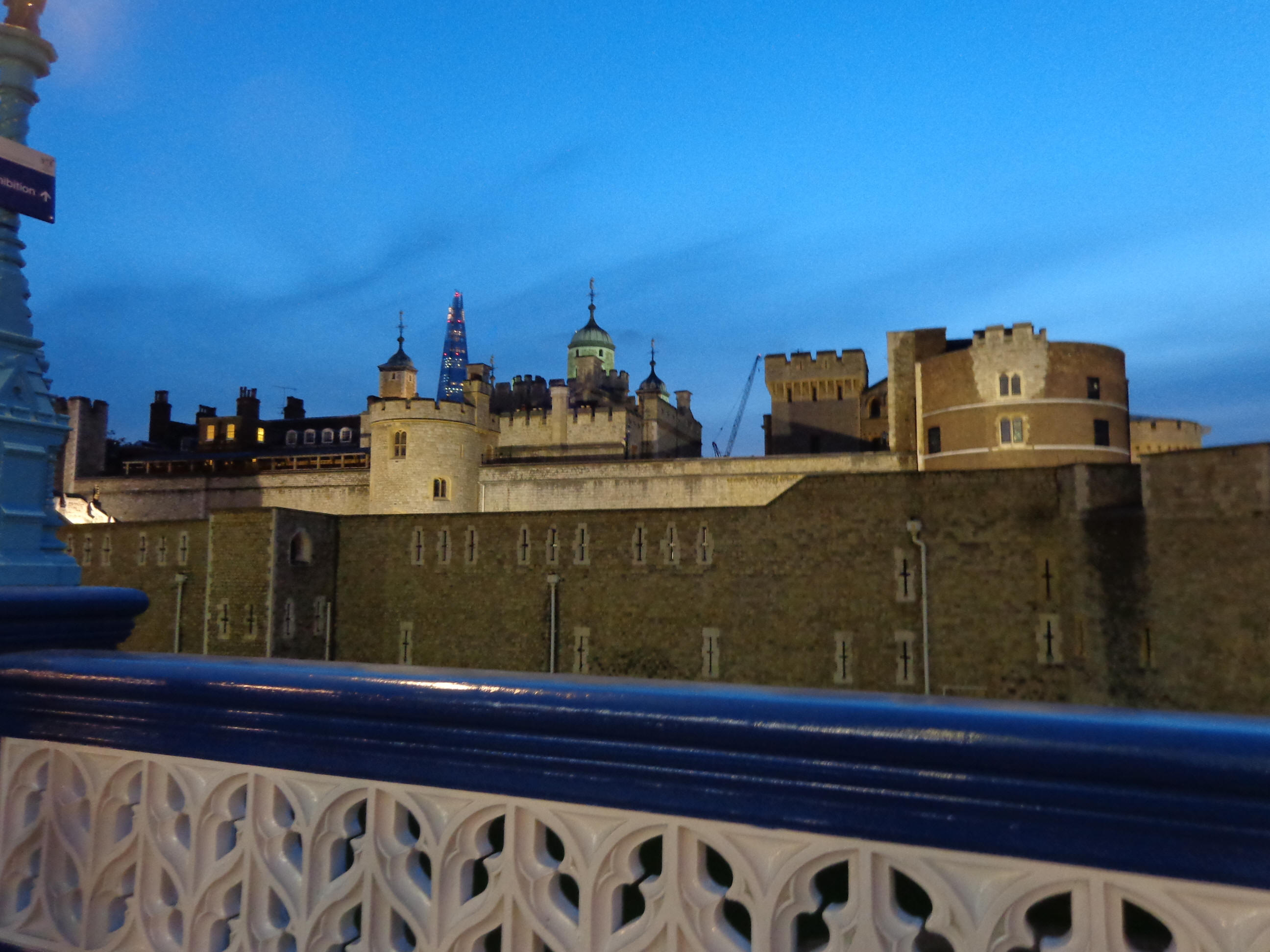 The Ceremony of the Keys is held every night at 9:30, in fact every
night for the past 777 years in the Tower of London. We will return to
the Tower of London tomorrow, and I will give its history. The evening
ceremony was rather impressive. The Master of the Keys gave some
explanation and the ceremony involved locking the main gate and several
others.
The Ceremony of the Keys is held every night at 9:30, in fact every
night for the past 777 years in the Tower of London. We will return to
the Tower of London tomorrow, and I will give its history. The evening
ceremony was rather impressive. The Master of the Keys gave some
explanation and the ceremony involved locking the main gate and several
others.
We found the metro and did the changes and got back home with no
problem. We had a very enjoyable and full day.

 coffee and two sweets.
coffee and two sweets.  books as I have bought one at every church that we
have visited.)
books as I have bought one at every church that we
have visited.)  Basilica – the northern most
part of the great Roman Forum built in the first century AD. It stands
near to the site of a church founded by King Lucius in AD 179 - the
oldest site of Christian worship in London. The name ‘Cornhill’ is first
mentioned in the 12th century, the ‘hill’ indicating the rising ground
on which St. Michael’s stands, and ‘corn’ being derived from the
corn-market which was once held there.
Basilica – the northern most
part of the great Roman Forum built in the first century AD. It stands
near to the site of a church founded by King Lucius in AD 179 - the
oldest site of Christian worship in London. The name ‘Cornhill’ is first
mentioned in the 12th century, the ‘hill’ indicating the rising ground
on which St. Michael’s stands, and ‘corn’ being derived from the
corn-market which was once held there.  The Church, with the exception of the tower, was completely
destroyed in the Great Fire of 1666. The present Church was rebuilt by
Sir Christopher Wren between 1669 and 1672. The interior, with its
majestic Tuscan columns, was beautified and repaired in 1701 and again
in 1790. Pre-Victorian features that remain in the Church today include
17th paintings of Moses and Aaron incorporated into the reredos, as well
as a wooden sculpture of 'Pe
The Church, with the exception of the tower, was completely
destroyed in the Great Fire of 1666. The present Church was rebuilt by
Sir Christopher Wren between 1669 and 1672. The interior, with its
majestic Tuscan columns, was beautified and repaired in 1701 and again
in 1790. Pre-Victorian features that remain in the Church today include
17th paintings of Moses and Aaron incorporated into the reredos, as well
as a wooden sculpture of 'Pe lican in her Piety' dating from 1775.
lican in her Piety' dating from 1775.  The interior was extensively remodelled in the High Victorian manner
by Sir George Gilbert Scott between 1857 and 1860. In addition, an
ensemble of stained glass was made by the firm Clayton & Bell and a new
porch, with a tympanum sculpture of St. Michael by John Birnie Philip,
was added.
The interior was extensively remodelled in the High Victorian manner
by Sir George Gilbert Scott between 1857 and 1860. In addition, an
ensemble of stained glass was made by the firm Clayton & Bell and a new
porch, with a tympanum sculpture of St. Michael by John Birnie Philip,
was added.  who
died on 16 April 1118. He was executed on the island of Egilsay having
been captured during a power struggle with his cousin, a political
rival. Magnus had a reputation for piety and gentleness and was
canonized in 1135.
who
died on 16 April 1118. He was executed on the island of Egilsay having
been captured during a power struggle with his cousin, a political
rival. Magnus had a reputation for piety and gentleness and was
canonized in 1135. dedicated to the Virgin Mary. In 1510, Sir Henry Keeble, a grocer and
Lord Mayor, finance the building of a new church on the site. When he
died in 1518 tower was unfinished and was not completed until 1629. The
church was among the largest and finest of the city churches and a
number of notables were buried there.
dedicated to the Virgin Mary. In 1510, Sir Henry Keeble, a grocer and
Lord Mayor, finance the building of a new church on the site. When he
died in 1518 tower was unfinished and was not completed until 1629. The
church was among the largest and finest of the city churches and a
number of notables were buried there.  t cost more to build than any of the parish churches after the
great fire and almost half of the money was spent on the steeple, which
is 230 feet high and surmounted by a dragon vein 9 feet long.
t cost more to build than any of the parish churches after the
great fire and almost half of the money was spent on the steeple, which
is 230 feet high and surmounted by a dragon vein 9 feet long.  yesterday,
is a new eight story modern building called One New Chance, which was
completed in 2010. It is a shopping center with sixty shops and
restaurants. The roof top is accessible so we went on top which is
about level with St. Paul’s dome. The photo is of Mike, Me and Val.
There were wonderful views of London.
yesterday,
is a new eight story modern building called One New Chance, which was
completed in 2010. It is a shopping center with sixty shops and
restaurants. The roof top is accessible so we went on top which is
about level with St. Paul’s dome. The photo is of Mike, Me and Val.
There were wonderful views of London.  Then we walked across the Millennium Bridge which is a modern
foot bridge across the Thames. Looking back across the bridge, there is
a wonderful view of St. Paul’s Cathedral.
Then we walked across the Millennium Bridge which is a modern
foot bridge across the Thames. Looking back across the bridge, there is
a wonderful view of St. Paul’s Cathedral. 
